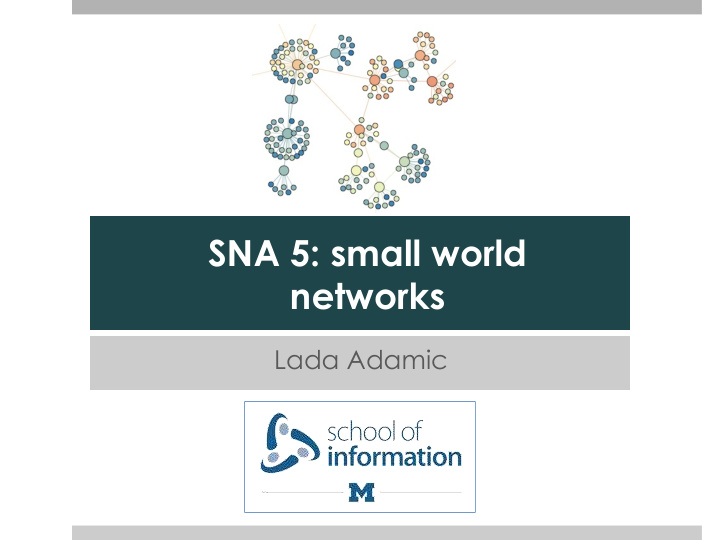



SNA 5: small world networks Lada Adamic
Outline ¤ Small world phenomenon ¤ Milgram ’ s small world experiment ¤ Local structure ¤ clustering coefficient ¤ motifs ¤ Small world network models: ¤ Watts & Strogatz (clustering & short paths) ¤ Kleinberg (geographical) ¤ Kleinberg, Watts/Dodds/Newman (hierarchical) ¤ Small world networks: why do they arise? ¤ Next week: what are the consequences for diffusion, coordination and learning.
Small world phenomenon: Milgram ’ s experiment MA NE
Milgram’s experiment Instructions: Given a target individual (stockbroker in Boston), pass the message to a person you correspond with who is “ closest ” to the target. Outcome: 20% of initiated chains reached target average chain length = 6.5 ¤ “ Six degrees of separation ”
Milgram’s experiment repeated email experiment Dodds, Muhamad, Watts, Science 301, (2003) (optional reading) • 18 targets • 13 different countries • 60,000+ participants • 24,163 message chains • 384 reached their targets • average path length 4.0 Source: NASA, U.S. Government; http://visibleearth.nasa.gov/view_rec.php?id=2429
Interpreting Milgram’s experiment n Is 6 is a surprising number? n In the 1960s? Today? Why? n Pool and Kochen in (1978 established that the average person has between 500 and 1500 acquaintances)
Quiz Q: ¤ Ignore for the time being the fact that many of your friends’ friends are your friends as well. If everyone has 500 friends, the average person would have how many friends of friends?
Quiz Q: ¤ With an average degree of 500, a node in a random network would have this many friends-of-friends-of-friends (3 rd degree neighbors):
Interpreting Milgram’s experiment n Is 6 is a surprising number? n In the 1960s? Today? Why? n If social networks were random … ? n Pool and Kochen (1978) - ~500-1500 acquaintances/person n ~ 500 choices 1 st link n ~ 500 2 = 250,000 potential 2 nd degree neighbors n ~ 500 3 = 125,000,000 potential 3 rd degree neighbors n If networks are completely cliquish? n all my friends ’ friends are my friends n what would happen?
Quiz Q: ¤ If the network were completely cliquish, that is all of your friends of friends were also directly your friends, what would be true:
complete cliquishness ¤ If all your friends of friends were also your friends, you would be part of an isolated clique.
Uncompleted chains and distance n Is 6 an accurate number? n What bias is introduced by uncompleted chains? n are longer or shorter chains more likely to be completed?
Attrition probability of passing on message position in chain average 95 % confidence interval Source: An Experimental Study of Search in Global Social Networks: Peter Sheridan Dodds, Roby Muhamad, and Duncan J. Watts (8 August 2003); Science 301 (5634), 827.
Quiz Q: n if each intermediate person in the chain has 0.5 probability of passing the letter on, what is the likelihood of a chain being completed n of length 2? n of length 5? sends for sure receives chain of length 2 passes on with probability 0.5
Estimating the true distance observed chain lengths ‘ recovered ’ histogram of path lengths inter-country intra-country Source: An Experimental Study of Search in Global Social Networks: Peter Sheridan Dodds, Roby Muhamad, and Duncan J. Watts (8 August 2003); Science 301 (5634), 827.
Navigation and accuracy ¤ Is 6 an accurate number? ¤ Do people find the shortest paths? ¤ Killworth, McCarty ,Bernard, & House (2005, optional): ¤ less than optimal choice for next link in chain is made ½ of the time
Small worlds & networking What does it mean to be 1, 2, 3 hops apart on Facebook, Twitter, LinkedIn, Google Plus?
Recommend
More recommend